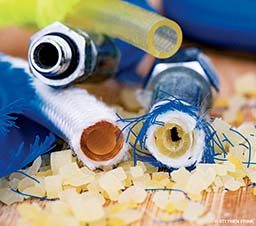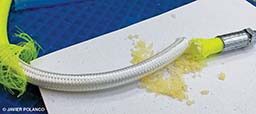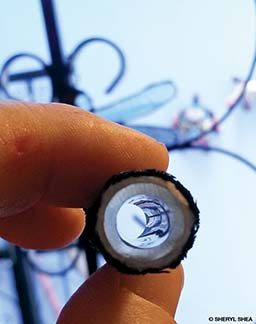Scuba equipment failure or malfunction is a relatively rare factor in diving-related accidents and fatalities. When it does occur, the most common and hazardous malfunctions involve regulators and buoyancy compensator (BC) power inflators.1 Thus, a recent report to DAN® of a regulator failure was not necessarily surprising, but the cause in this particular case turned out to be quite unusual.

Although the diver involved in the incident managed the situation very well, and no one was harmed, an inexperienced or nervous diver might not have been so fortunate. It was particularly strange that although the diver’s cylinder was not empty, the gas flow had slowed and then ceased in a way that resembled an out-of-air situation. Closer examination of the equipment led to a puzzling discovery: A large amount of yellow crystallized material was blocking the inside of the braided second-stage regulator hose. The hose had been in use for a few years but showed no external abnormalities or signs of deterioration.
While trying to solve the mystery, we discovered this was not an isolated case. The same situation occurred July 22, 2015, and was reported subsequently in a technical diving blog.2 Further reports from a hose manufacturer and at least one equipment-servicing workshop in a popular diving region revealed that these were not isolated events. Although no injuries have been reported, the discovery prompted a wider, global investigation, which is ongoing.
Analysis revealed the culprit to be a form of polymorphic crystallization — a phenomenon associated with cyclical heating and cooling at oil-water interfaces.3 In both incidents, the crystallization seemed to be related to the molecular structure of the internal tube. The current theory is that repeated cyclical heating and cooling of the hose lining promotes this form of crystallization in materials either unsuitable for this application or affected by certain chemicals or bacteria. The sun heats the hose, then the flow of breathing gas cools down the internal surface of the hose again. This process recurs with each dive, and the crystals grow and accumulate over time. Enough crystals eventually form to encroach on the gas flow, or they migrate toward the second-stage regulator, resulting in significant failure of the breathing device.

So far the reported incidents have been in tropical climates with gear that is several years old. We have not received reports of this problem with vinyl hoses, and given the number of braided hoses out there (both as original components and replacement parts) the incidence is likely quite small. But because this hazard threatens divers’ air supplies, it is of great potential interest to the dive community. The challenge is determining how best to respond to this discovery. It’s important to identify what divers need to know right now as well as what precautionary maintenance guidelines and early detection strategies they should implement at this stage.
The standard safety recommendation regarding regulator hoses has been that they should be inspected regularly for signs of external deterioration. Disintegration or abrasion of the outer rubber coating eventually predisposes hoses to rupture during pressurization or even when in use. Rubber hoses are quite prone to this condition, which is why polymer-braided hoses were developed. But herein lies the problem: The outside of braided hoses can appear normal, flexible and free from obvious abnormalities, while a deteriorated internal surface would be completely invisible to a cursory external inspection.
It would be premature to speculate that this deterioration is limited to braided hoses. Previously, hoses comprised a rubber inner hose, a single braid layer for reinforcement and finally a rubber outer sealing layer. Today the rubber inner hose is sometimes replaced with a polyurethane or nylon hose (referred to as thermoplastic). The middle or reinforcing layer is a polymer-filament braid, and the outer layer is either a second braid — which has the advantage of indicating when the inner hose has a leak — or a polyurethane or synthetic-rubber sealing layer.
Newer second-stage hoses with a thermoplastic inner layer may be vulnerable to degradation. This risk does not apply to internal layers of synthetic rubber, which appear to be impervious to this phenomenon. DAN Research would normally wish to conduct more in-depth analysis with a wider sample of defective hoses, but because this is a potential hazard to regulator function we prefer to err on the side of caution and report this phenomenon now.
What Does DAN Recommend?
DAN has contacted manufacturers of outer braided hoses to assess possible causes and precautionary measures, and we feel it is important to advise divers as follows:

- All regulator hoses, including braided hoses, have a limited service life regardless of external appearance or reinforcement and protection provided by hose protectors or the braiding itself. The failed hoses we have seen are more than five years old.
- The internal section of newer hoses with a thermoplastic inner layer appears to be uniquely prone to polymorphic crystallization, especially in hot, tropical locations. The phenomenon appears to be a gradual process, but the disruption of gas flow and regulator function is unpredictable and invisible to external inspection.
- If there is any indication of gas-flow restriction, particularly when using a newer hose, the diver should immediately stop using the regulator. Perform a careful inspection of the regulator and the hose. If the regulator is not the cause, suspect the hose.
- Physically examine hoses by squeezing them every inch or so to assess whether they exhibit the same degree of flexibility. Any change in resistance while squeezing along the length of the hose would be a sign of a possible problem. This test is much easier to perform with braided hoses than with harder, outer rubberized hoses.
Following this advice, especially the recommendation to regularly inspect hoses, will give you greater confidence that your hoses will perform as they should. Advocate for dive safety by promoting the following ABC strategy:
- Air awareness: Make all divers aware of this problem and the need for regular equipment servicing.
- Buddy breathing: Practice emergency air-sharing procedures to ensure preparedness for and appropriate action in the event of regulator failures or out-of-gas situations.
- Customer choice: Ensure that any hose purchased displays on the ends information about the manufacturer, the production date and the standard used. Check that this information is consistent with that on the packaging.
We ask all divers who observe this inner-hose degradation to please email DAN at , preferably providing pictures that show the condition of the hose. This will enable us to capture as much information as possible so we can learn more about this phenomenon. We will share any new findings, cautions and advice with the diving community.
References
- Vann R, Lang M. Recreational diving fatalities. Undersea Hyperb Med 2011; 38(4): 257-60.
- Davis A. Nylon-braided regulator hose diving emergency. Scuba Tech Philippines. July 22, 2015. scubatechphilippines.com/scuba_blog/regulator-hose-diving-emergency/#Polymorphic_Crystallization. Accessed December 7, 2016.
- Douaire M, di Bari V, Norton JE, Sullo A, Lillford P, Norton IT. Fat crystallisation at oil-water interfaces. Adv Colloid Interface Sci 2014; 203: 1-10.
| © Alert Diver — Q1 2017 |